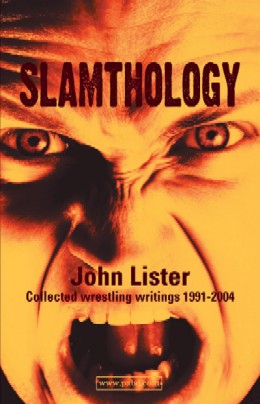Over the past few years, the wrestling industry has seen a number of books written and published by current and former wrestlers and personalities. Such books offer readers an intimate look into this unfamiliar world through personal accounts, but most are limited by biased opinions and perspectives.
A British journalist has taken a different approach of reaching and informing readers. John Lister, a well-respected wrestling scribe in the UK, has put together a collection of some of his more memorable works, both from his early days reporting on wrestling to more current pieces, spanning from 1991 to 2004.

Slamthology is composed of articles and columns Lister crafted and, in many cases, published in his fanzine Hulk Who? The British writer, who has been reporting on the wrestling industry for over 10 years, delivers a wide range of pieces, from road reports and events, to humorous and historical bits.
The real strength of Lister’s book is his writing style – clear, conversational, and very easy to grasp. Lister, regardless of topic, is able to explain a variety of aspects of this often very complicated subject matter. And in Slamthology, much is explained.
Slamthology begins with a comprehensive and very detailed look at the history of American wrestling, and all in under 1,500 words. As such, Lister packs a lot of facts into a very limited space, but his experience and knowledge of the business allow him to do so effectively.
Lister’s focus then shifts to reports he wrote during three trips to America, as published in Hulk Who? During his time in the States, Lister attended a variety of WWF/E, ECW, WCW and independent shows, providing detailed accounts of each trip. Lister’s humour make this by far the most enjoyable and easy-to-read section.
Lister, while traveling with a variety of characters, tells tales one would expect more from a grappler than journalist – low-budget hotels, spending countless hours traveling from show to show, press conferences, fast food restaurants, and meeting unique individuals which could only be found at a wrestling show (i.e. the fans).
By his third report, one certainly gets the impression that the British journalist has paid his dues in the business, maintaining a similar lifestyle to that of an ECW performer. However, all is soon forgotten as Lister lives every hard-core wrestling fan’s dream by attending a barbecue hosted by none other than Terry Funk. And, yes, it takes place at the Funk Ranch.
The real benefit of Lister’s USA road journals is the trip down memory lane he takes the reader on, rehashing some of wrestling’s more notable and recent angles, feuds, and shows. In addition, Lister recounts how some of today’s stars got their start in the business, working for small, independent promotions before hitting the big time.Lister then changes gears in the second half of the book, focusing more on his articles, some never-before published, including a selection of very informative historical and opinion pieces. The real value for the reader comes from columns Lister penned on WCW’s demise, his argument that journalists can effectively and accurately report on the business (despite what some wrestlers think), the history of British wrestling, and a fascinating piece on Jim Barnett and his impact on the business.
Lister covers a lot of ground in his book, touching on a wide variety of topics. And while this certainly leads to the book’s success, it also takes away from any real flow or continuity.
Throughout the book, the one obvious common denominator is wrestling, as it should be. The problem is the articles in the second half seem to be placed using a shotgun approach. Lister explains earlier on that the articles are in a chronological order. Fair enough. But, in cases where articles were produced under a similar theme, heading or series, combining them would have been much more effective.
As such, Lister throws a variety of works at the reader, hitting in some cases but missing in others. Articles such as the No-Show ditties, a bit on Nic Higton, and selections from the “What if…” series, to name a few, leave the readers scratching their collective heads searching for a purpose. At a lengthy 345 pages, some of this “filler” material could have been left on the cutting room floor. Perhaps the use of a glossary may have helped resolve this problem.
In place of these stories, a very welcome addition would have been the use of visual materials — event programmes with match line ups, promotional photographs of wrestlers before they were stars, or even ticket stubs. Surprisingly, the book offers text only, which tends to drain the reader mentally. A good collection of images scattered throughout the book would have provided readers with a bit of a break in between sections. As well, when the opportunity presents itself, why say in 100 words what a picture can sum up in one?
Considering the number of events Lister attended during his travels throughout the U.S., surely some memorabilia was attained, especially from the small-town and indy shows. As well, for readers unfamiliar with Hulk Who?, which receives much mention in this book, a cover or two would seem to be an automatic insert. Even a picture of the author himself would have helped readers visualize Lister as he traveled from town to town.The only other element which readers, mainly Canadian or American, may find distracting is Lister’s British English. Terms and phrased used commonly in Great Britain may distract first-time Lister readers, as a majority of North American fans do not speak the Queen’s English.
All in all, Lister’s Slamthology is a good read for both fans of the business and journalists. Lister’s unique and informed opinions, knowledge of the business, and entertaining tales will, if anything, provide fans with a new, unbiased British perspective on the business of wrestling.












